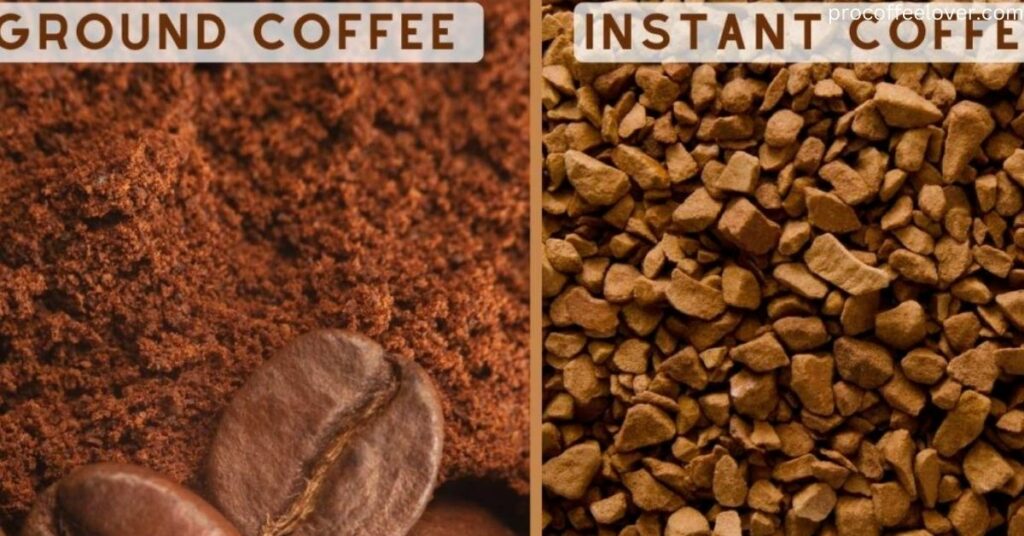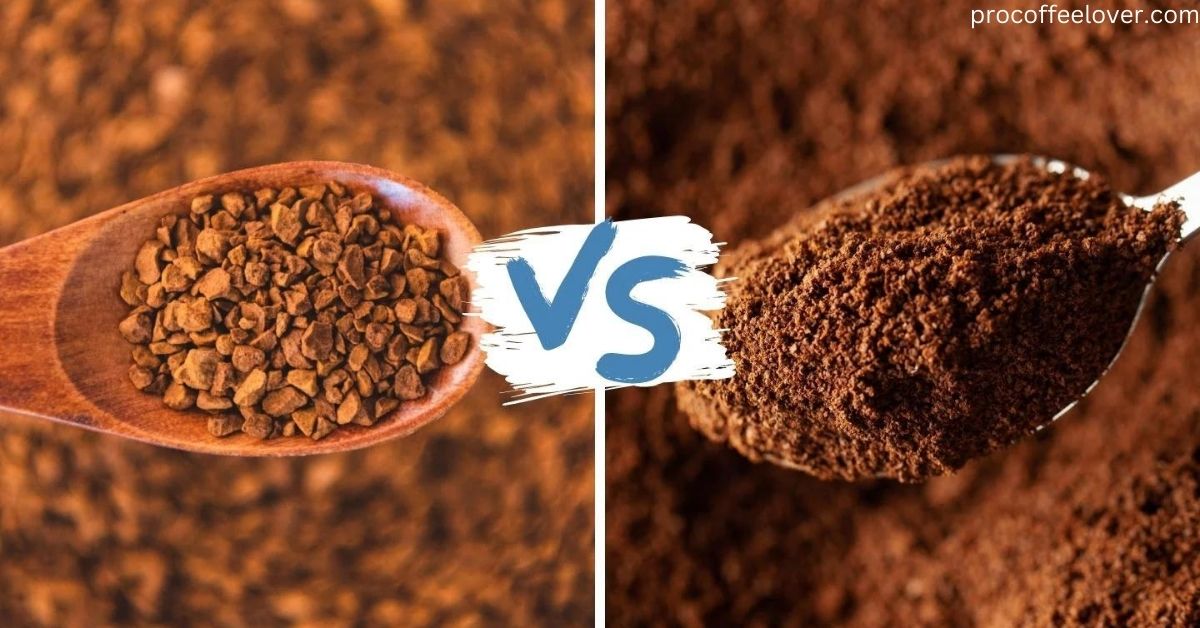Let’s discuss Instant Coffee Vs. Ground Coffee.Coffee is essential to many people’s morning routine. Instant coffee has become popular due to its convenience. However, some argue that fresh ground coffee has better flavor and aroma.
This article will compare instant and ground coffee in terms of taste, caffeine content, preparation methods, cost, health benefits, and environmental impact. Instant coffee is made by spray-drying coffee beans into powder or granules, while ground coffee is coarsely ground roasted beans.
Instant coffee dissolves quickly but lacks depth of flavor. Ground coffee takes more time and effort but offers a fresher taste. Learn more about the differences between instant and ground coffee and decide which suits your preferences and lifestyle better.
How Instant And Ground Coffee Are Made
Instant Coffee Production
Coffee beans are first roasted, ground and brewed into a concentrated liquid coffee extract to make instant coffee. This liquid is then spray-dried or freeze-dried into powder or granules.
Spray drying involves spraying the liquid into hot gas, instantly evaporating the water and leaving dried coffee solids behind. Freeze drying uses frozen temperatures to turn the liquid concentrate directly into coffee powder.
Drying and granulating the coffee this way allows it to dissolve almost instantly in hot water. The resulting instant coffee delivers the convenience many consumers demand in today’s fast-paced world. However, the process also removes volatile compounds and aromatic oils, significantly losing flavor nuance.
Ground Coffee Preparation

Ground coffee starts with whole-roasted coffee beans. The beans are placed in a grinder and coarsely ground to a preferred consistency from fine to extra coarse. Coarser grinds are recommended for drip coffee makers, while espresso methods utilize a finer powder-like grind.
The grind size affects the flavor by controlling brewing time. Once ground, the coffee can be scooped into a brewing device like a French press or filter drip machine. Hot water gets poured over the grounds,
extracting oils, acids and aromatic compounds that dissolve into the final brewed coffee. Because this extraction happens freshly, it better preserves the volatile elements of coffee’s complex taste and aroma. Ground coffee offers fuller-bodied flavor but trades off some convenience compared to instant.
Taste And Flavor Profile
Instant Coffee Taste
Due to the soluble nature of instant coffee granules, the resulting taste is often weaker and flatter than ground coffee. Significant aromatics are lost during drying and granulation. While spray-dried instant aims to protect the coffee’s oils, it still results in a less vibrant, nuanced flavor.
Tasting notes common to instant coffee include toasted grain, malt, brown sugar, and ash-like burnt flavors. Some instant coffee brands use cheaper, lower quality beans, detracting from potential taste.
That said, freeze-dried instant coffee has improved over the years, sometimes with decent malt, chocolate and caramel notes when made from quality beans.
Overall, though, instant coffee sacrifices peak fresh flavor in exchange for fast preparation and shelf-stability. Many instant coffee drinkers add dairy, sweeteners or flavors to liven up the underwhelming black coffee taste.
Ground Coffee Taste

Because ground coffee is freshly extracted, it delivers a significantly more aromatic, vibrant flavor that coffee connoisseurs crave. The broad spectrum of tastes and smells from thousands of volatile compounds can be appreciated.
Tasting notes depend on the origin, roast and grind size but often include hints of caramel, nuts, citrus, berries, chocolate, toffee, and spices. High-quality Arabica beans’ natural sweetness and acidity can shine through when ground and brewed correctly.
With the right grind size and brewing method, ground coffee can extract the nuanced flavors and bolder base notes for a well-balanced cup. While instant coffee narrowly focuses on replicating standard black coffee, ground beans offer an endless range of customizable flavor experiences through different beans, roasts, grinds, and brewing styles.
Also,see more about Single Shot Vs. Double Espresso Shots.
Caffeine Content
Instant Coffee Caffeine Levels
Instant coffee contains slightly less caffeine than freshly brewed ground coffee. Exact amounts can vary between brands, but on average, instant coffee has 30-90mg of caffeine per 8oz cup. This compares to 70-140mg of caffeine for average ground coffee.
What accounts for the lower caffeine levels? In the process of extracting liquid coffee concentrate to dry into powder, some caffeine is lost. Up to 20% less caffeine may be extracted than traditional brewing methods.
However, instant coffee still provides enough caffeine to produce the energizing lift coffee drinkers desire. Those sensitive to caffeine may even find instant coffee more palatable with its marginally reduced amounts. Be aware that caffeine will be higher if using more teaspoons of instant granules per cup.
Ground Coffee Caffeine Content
Freshly brewed ground coffee tends to contain moderately higher caffeine levels than instant coffee. Ground coffee averages 70-140mg of caffeine per 8oz serving. Drip coffee lands around 70-90mg on the lower end, while French press and espresso contain over 100mg per serving.
The longer brew times associated with these methods extract more caffeine from the grounds. Light roasts also retain more caffeine than darker roasts.
The caffeine content in ground coffee comes down to the specific bean origin, roast style, grind size, brewing time and strength of ratio. Unlike instant coffee production, ground coffee brewing does not degrade or evaporate the caffeine molecules.
While caffeine levels are not extremely high, ground coffee makes it easy to get the satisfying daily caffeine fix many coffee lovers crave.
Preparation Methods
Preparing Instant Coffee
One of the biggest appeals of instant coffee is how quickly and easily it can be prepared. Add one or two teaspoons of instant coffee granules or powder to a cup of hot water to make basic instant black coffee. The standard ratio is one teaspoon per 6-8oz cup.
Then, stir briefly until the coffee dissolves, usually 10-20 seconds. Some instant coffee brands recommend using water between 165-185°F to optimize extraction, but lower temperatures still work. The convenience of instantility lies in its solubility, allowing it to dissolve rapidly.
Packets of instant coffee or ESB (easy soluble bags) also make on-the-go preparation easy. Unlike brewing ground coffee, no equipment is needed other than hot water. Mix and enjoy your morning cup of instant coffee in under a minute.
However, the tradeoff for convenience is the lack of customizable brewing options that ground coffee affords.Also, see more about Bottomless Portafilter vs. Regular.
Preparing Ground Coffee

Brewing methods for ground coffee are diverse, but the basic process is:
- Choose your preferred roast whole bean or coarse ground coffee. Dark, medium or light can be used.
- Grind the beans to your desired coarseness. Medium grind works for most drip machines.
- Measure the grounds using a standard coffee scoop or weighing with a scale.
- Brew with your preferred method: Drip machine, French Press, AeroPress, Espresso, etc.
- Adjust strength as needed by changing grind amount, water ratio or brew time.
- Enjoy immediately to experience peak freshness and aroma.
The time and effort required are a downside, but they unlock immense flavor complexity and customization potential. With the right tools and some practice, brewing ground coffee can become a fun, engaging morning ritual superior to instant’s one-note taste.
Cost Analysis
Instant Coffee Price Comparison
Instant coffee is generally cheaper than ground coffee, costing around $0.50 to $1.00 per 2-3oz jar on average. Larger bulk containers of instant coffee can bring the per-ounce price down even more.
Due to freeze-dried coffee’s higher production costs, this version is pricier, from $1.00 to $3.00 for 2-3oz. Considering an average serving uses 1-2 teaspoons, instant coffee can cost just $0.10-$0.30 per cup, depending on brand and quantity.
Significant brands like Folgers and Maxwell House sell budget-friendly instant coffee options widely available at grocery stores. Overall, instant coffee’s convenience and lower price point make it very economical. Saving time and money are the key selling points.
While still affordable, ground coffee costs more per serving compared to instant. For budget-minded coffee drinkers who value price over taste, instant coffee provides the biggest bang for your buck.
Ground Coffee Price Comparison
Quality ground coffee is more expensive than instant, generally priced between $8 to $20 per 12oz bag. Specialty beans can cost upwards of $18-30 for a 12oz bag. Buying whole beans and grinding them fresh is recommended for peak flavor. Ground coffee costs around $0.20 to $0.50 per cup, depending on the brewing method and coffee-to-water ratio.
Conventional brands like Folgers and Maxwell House offer cheaper options starting around $6 per 12oz bag. For high-end specialty coffee from roasters like Blue Bottle and Stumptown, expect to pay over $14+ for 12oz.
While pricier than instant per cup, keep in mind you recoup some costs by grinding only the needed amount per brew instead of purchasing prepared instant cups/packets.
Investing in ground coffee and proper brewing tools results in an elevated drinking experience that devotees find well worth the slight added expense.
Health Benefits
Instant Coffee Health Claims
While less studied, instant coffee does provide some health advantages thanks to containing antioxidants and polyphenols:
- Lower risk of heart disease, stroke, and cancer
- Reduced inflammation
- Increased fat-burning and metabolic rate
- Improved brain function and mood
However, some research indicates that freshly brewed ground coffee has slightly higher antioxidant levels. One study found 2-5x more antioxidants in ground coffee compared to instant. This is likely because some micronutrients degrade during instant coffee production.
The freeze-drying process may help retain more polyphenols and nutrients than spray-drying methods. Overall, instant coffee still delivers health benefits but is marginally reduced compared to ground. Moderate consumption, around 3-4 cups daily, is recommended to maximize instant coffee’s antioxidant potential.
Ground Coffee Health Benefits
A growing body of research demonstrates extensive health benefits conferred by ground coffee’s wealth of antioxidants and anti-inflammatory compounds:
- Reduced risk of type 2 diabetes, Alzheimer’s, Parkinson’s, heart disease, and liver disease
- Increased cognitive function and mood
- Improved physical performance and fat-burning
- Higher antioxidant levels than instant and tea
Caffeine itself also provides cognitive and physical performance benefits when consumed in moderation. The polyphenols and antioxidants in ground coffee are associated with decreased inflammation and oxidative stress.
These compounds are best preserved through quality bean selection and optimized fresh brewing practices. Consuming 3-4 cups of freshly brewed ground coffee daily provides maximum health benefits while mitigating risks.
Overall, ground coffee makes it easier than instant to extract the full spectrum of bioactive compounds that grant extensive short and long-term health benefits.
Environmental Impact
Instant Coffee Environmental Effects
While slightly more efficient to transport due to reduced weight and volume, instant coffee still generates significant greenhouse gas emissions from production, shipping and waste. Spray and freeze-drying methods require substantial energy inputs for operation.
The packaging for individual instant coffee packets also contributes to landfill waste and pollution. However, Nestle’s leading initiatives are to source sustainable coffee beans, reduce plastic packaging, and implement eco-friendly manufacturing processes.
For consumers, the simplest way to mitigate instant coffee’s environmental impact is to purchase large containers instead of single-serve packets, which generate more waste.
It is estimated that instant coffee produces around 20% less carbon emissions than ground coffee. So, while not wholly guilt-free from an environmental perspective, instant coffee has a slight advantage over the ground regarding its overall carbon footprint.
Ground Coffee Environmental Considerations
Ground coffee requires more energy and resources to grow, harvest and roast the beans, then grind, pack and ship the final product. Significant water and land use is necessary to cultivate coffee plants. Once beans reach roasting facilities, operating commercial equipment requires substantial electricity and natural gas.
Additional packaging is necessary to deliver whole-bean or ground coffee to consumers. Waste is generated from the one-time use of coffee filters, pods, and disposable cups. An estimated 150 billion disposable cups end up in landfills globally each year.
Consumers can help by purchasing reusable K-cups, switching to reusable filters, and requesting reduced packaging. Opting for local roasters that use sustainable practices can also lessen environmental tolls. While ground coffee is less eco-friendly than instant, small consumer changes and industry improvements can still add positive impacts.
(Instant Coffee Vs. Ground Coffee)Frequently Asked Questions
Which Has A Longer Shelf Life, Instant Or Ground Coffee?
Instant coffee lasts significantly longer, around 2-20 years, due to the low moisture content—ground coffee peaks in freshness between 2 weeks to 1 month after roasting. Oils deteriorate faster, causing stalling.
Is Instant Coffee Unhealthy?
No, instant coffee contains similar antioxidants and nutrients as ground coffee. However, some micronutrients are slightly reduced through manufacturing. Consumed in moderation, instant can be part of a healthy diet. Avoid added sugars or dairy for maximum benefits
Is ground Coffee better For you?
Yes, ground coffee retains more antioxidants through direct bean grinding and brewing. The whole flavor experience of fresh ground coffee also allows you to use less per cup, reducing any risks of excess caffeine consumption.
Conclusion
Finally we learned Instant Coffee Vs. Ground Coffee.While instant and ground coffee originates from the same beans, their production, taste, cost, and preparation differences are substantial. Instant coffee privileges speed and cost savings but needs more flavor complexity. Ground coffee provides a fresher, bolder tasting experience yet requires more time and equipment to brew.
Both offer caffeine and some nutritional merits. Ultimately, lifestyle factors and personal priorities will determine whether soluble instant or fresh-ground coffee is right for you.
